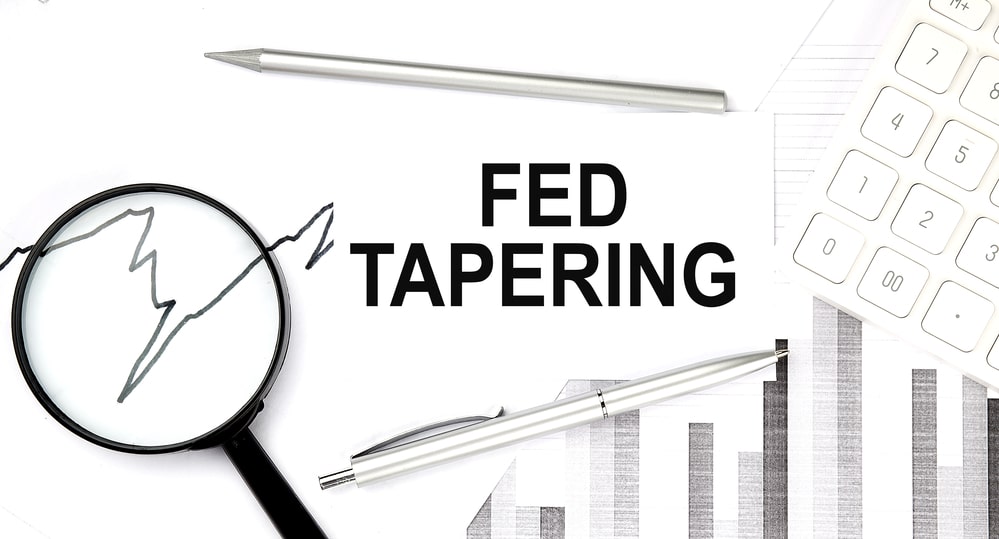
Central banks, such as the Federal Reserve of the United States (Fed), have a wide range of powers to control the economy’s health. One of them is buying asset-backed securities to help the economy recover. When central banks purchase assets from their member banks, money is returned to the economy. Quantitative easing (QE) is the practice of buying assets while keeping interest rates low. Central banks, on the other hand, cannot continue to acquire securities and inject money into the economy indefinitely. They focus on cutting down asset purchases once they consider the economy has recovered sufficiently. This is what is referred to as tapering.
How does Fed tapering work?
Individual borrowers and corporations are encouraged to take out loans while central banks maintain short-term interest rates low; this stimulates the economy. At the same time, the central bank purchases assets to infuse money into the economy. Central banks will progressively taper their asset purchases once they have accomplished their aim of economic recovery. Tapering has an influence on the supply of these assets and has the potential to shift not just the bond markets in the United States but also stock markets throughout the world.
Restrictions imposed by the COVID-19 epidemic in March 2020 have enormous repercussions on the US economy and financial markets. On March 23, 2020, the central bank announced a raft of steps to safeguard financial stability, including the purchase of bonds. Every month since June 2020, the Fed has acquired an average of $80 billion in US Treasury bonds and $40 billion in mortgage-backed securities.
Fed Chair Jerome Powell stated in August 2021 that it might be reasonable to begin lowering the rate of asset purchases this year. The economy has made substantial additional progress, according to Powell, pushing the Fed to consider a taper. He went on to say that the tapering will most likely end by the middle of 2022 at a subsequent press conference.
Why did the Fed start tapering and possible outcomes in 2022?
Concerns that increasing inflation may hurt the economy were undoubtedly a major factor in the Fed’s decision to alter its policy. Inflation refers to the rate of change in the price of goods and services. The Consumer Price Index, which covers a variety of ordinary things that a normal consumer may purchase, is the most commonly cited indicator of inflation in the media. It has increased by 5.4 percent over the previous year by October 2021.
The Fed, on the other hand, favors the core Personal Consumption Expenditures gauge of inflation since it removes volatile food and energy costs, unlike the CPI. This other index, which is often lower than the CPI, has risen somewhat less, or 4.4 percent, during the same time period. In recent months, however, both metrics have been over the Fed’s objective of 2% annual inflation. Many analysts have interpreted this increasing trend as a sign that the Fed may be forced to raise interest rates sooner rather than later, thereby slowing economic growth.
The Fed highlighted indicators that the US economy is growing, “progress on vaccines,” and rising inflation as significant concerns in its November statement as it began to scale back its asset purchases. The Fed, on the other hand, stated that it plans to maintain an “accommodative” monetary policy stance – that is, it would maintain its assistance in the form of low-interest rates and other measures – until maximum employment and price stability are achieved.
Consumer costs may have recently risen due to temporary variables related to the pandemic, including increases in the cost of used automobiles, increased consumer demand, and supply chain issues. For the time being, that’s how the Fed sees it, and it’ll be keeping a careful eye on inflation in the coming months. Mortgages, loans, and other sorts of borrowing are already seeing somewhat higher rates for consumers and businesses. At the same time, investors are anticipating a faster than expected rise in the Federal Reserve’s benchmark interest rate. The Fed also pushed out the start of interest rate hikes from 2023 to 2022.
Tapering impact
While analysts think the Fed has been more measured in its messaging on tapering this time around, consumers should expect volatility, at least in the stock market. Maintain a long-term perspective and avoid making knee-jerk reactions to market downturns. Better still, see each market downturn as a purchasing opportunity, according to McBride.
It’s also unclear how the Fed’s ultimate reduction will affect mortgage rates. When the biggest buyer in the market withdraws, yields often rise, which might lead mortgage and refinancing rates to rise as well. When purchasing Treasuries, however, investors consider their inflation predictions.
Mortgage rates started to go up in the weeks after the Fed meeting, with experts blaming it on the Fed’s taper at its November meeting. However, towards the end of October, the 10-year US Treasury yield fell to its lowest level since July, as investors anticipated slower economic growth and rising inflation.
The Federal Reserve has stated that tapering does not imply that rate rises are imminent, though increased inflation and a strong labor market may force officials’ hands. Policymakers are already raising their rate estimates, with the Federal Reserve’s September projections indicating a rate rise as early as 2022.
2013 tapering vs. 2021 tapering
Many economists and professionals believe that the taper tantrum of 2013 will not be repeated in 2021. The main reason is that markets anticipate a taper in 2021, so a knee-jerk reaction like the one saw in 2013 is improbable.
Fed Chair Powell, who served on the FED’s Board of Governors during the previous taper, stated in March 2021 that the central bank would “provide unambiguous communication” far ahead of the actual reduction.
The impact on developing economies is also projected to be less severe this time around, according to experts, because those nations’ external balance sheets have strengthened, and they are less exposed this time.
Conclusion
The policy of unwinding the Fed’s huge purchases of Treasuries and mortgage-backed securities since the outbreak of COVID-19 is known as tapering. In what is known as quantitative easing, the Fed has purchased almost $4 trillion in Treasuries and other assets since March. The FED has started reducing these assets purchases. Tapering has effects on consumers, one of which is, mortgage rates have started going up. Tapering will end in mid-2022, according to the Fed chair.







Leave a Reply